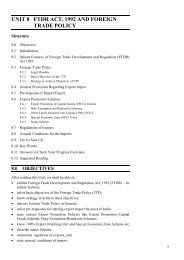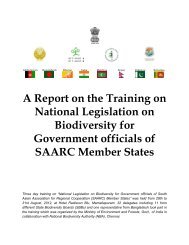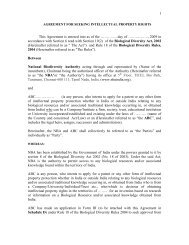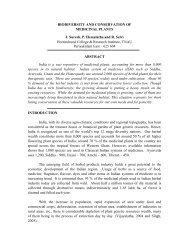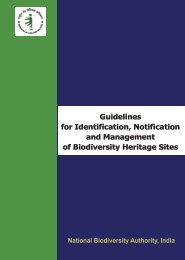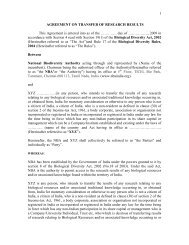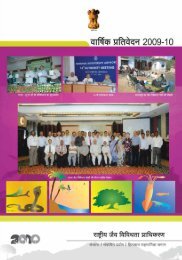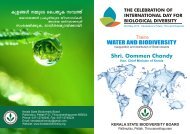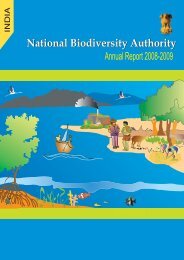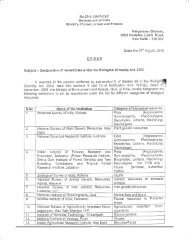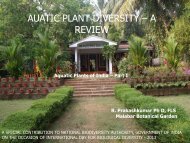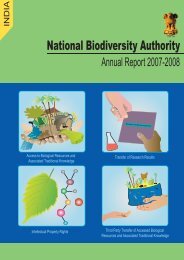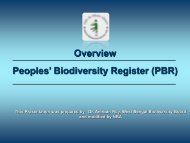Part 1 - English version (PDF) - Convention on Biological Diversity
Part 1 - English version (PDF) - Convention on Biological Diversity
Part 1 - English version (PDF) - Convention on Biological Diversity
You also want an ePaper? Increase the reach of your titles
YUMPU automatically turns print PDFs into web optimized ePapers that Google loves.
India’s Fourth Nati<strong>on</strong>al Report to the <str<strong>on</strong>g>C<strong>on</strong>venti<strong>on</strong></str<strong>on</strong>g> <strong>on</strong> <strong>Biological</strong> <strong>Diversity</strong><br />
<br />
<br />
<br />
<br />
<br />
<br />
<br />
<br />
A Nati<strong>on</strong>al Tiger C<strong>on</strong>servati<strong>on</strong> Authority (NTCA) has been set up in 2006 to strengthen tiger<br />
c<strong>on</strong>servati<strong>on</strong> efforts.<br />
The WII, a premier training and research instituti<strong>on</strong>, maintains a ‘Nati<strong>on</strong>al Wildlife Database’,<br />
that provides up-to-date informati<strong>on</strong> <strong>on</strong> the PA network of the country.<br />
Since the adopti<strong>on</strong> of the ‘Programme of Work <strong>on</strong> PAs’ by the CBD in 2002, India’s PA network<br />
has increased by 15 per cent.<br />
India has a NWAP which envisages 10% of the geographical area of the country under PA<br />
coverage. The extent of the formal PA network, at present, is around 4.8%. However, it is<br />
pertinent to note that almost all state owned forests and other important ecosystems which are<br />
outside the PA network are under some kind of broad based c<strong>on</strong>servati<strong>on</strong> planning. In additi<strong>on</strong>,<br />
there are several community driven c<strong>on</strong>servati<strong>on</strong> initiatives in the country in the form of sacred<br />
groves, p<strong>on</strong>ds, turtle nesting sites, etc. If all these are taken into account, biodiversity c<strong>on</strong>servati<strong>on</strong><br />
is the core management paradigm in around <strong>on</strong>e-fifth of the geographical area of the country,<br />
whereas broad based c<strong>on</strong>servati<strong>on</strong> planning is also practiced in most of the other producti<strong>on</strong><br />
sectors such as agriculture, fisheries, animal husbandry, etc.<br />
Expansi<strong>on</strong> of PA network is envisaged in the NEP. In order to strengthen and c<strong>on</strong>solidate the<br />
existing wildlife c<strong>on</strong>servati<strong>on</strong>/management efforts, a modified nati<strong>on</strong>al scheme titled ‘Integrated<br />
Development of Wildlife Habitats’ has been launched in 2008. Apart from providing support to<br />
PAs, the scheme extends financial and technical support to high value biodiversity formati<strong>on</strong>s<br />
outside the formal PA network (including traditi<strong>on</strong>al and customary c<strong>on</strong>servati<strong>on</strong> practices like<br />
CCAs and also provide for initiating recovery programmes for select critically endangered species.<br />
Recommendati<strong>on</strong>s are in place to establish additi<strong>on</strong>al PAs (67 new NPs and 203 new WLSs) to<br />
make it more biogeographically representative. However, due process as per the provisi<strong>on</strong>s of the<br />
WPA and other relevant legislati<strong>on</strong>s needs to be followed for the establishment of new PAs. More<br />
efforts are also needed to plan and establish new marine PAs.<br />
A Task Force has been c<strong>on</strong>stituted with mandate to identify potential areas that can be declared<br />
as Trans-boundary PAs (TBPAs) and a nati<strong>on</strong>al c<strong>on</strong>sultative process for planning and establishing<br />
TBPAs has been initiated. Five TBPAs have been identified for enhancing regi<strong>on</strong>al cooperati<strong>on</strong><br />
with neighboring countries out of the 24 PAs featured in the regi<strong>on</strong>al network of TBPAs under<br />
the IUCN framework. Provisi<strong>on</strong> for the<br />
implementati<strong>on</strong> of TBPAs has been<br />
incorporated in the scheme of ‘Integrated<br />
Development of Wildlife Habitats’.<br />
Management Plans of PAs have been<br />
developed by applying the ‘ecosystem<br />
approach’, which provides for a core-buffer<br />
strategy for wildlife c<strong>on</strong>servati<strong>on</strong>. It is<br />
envisi<strong>on</strong>ed that whereas the core areas/<br />
critical wildlife habitats are to be largely<br />
inviolate, co-existence agenda is to be<br />
promoted in the buffer.<br />
50



